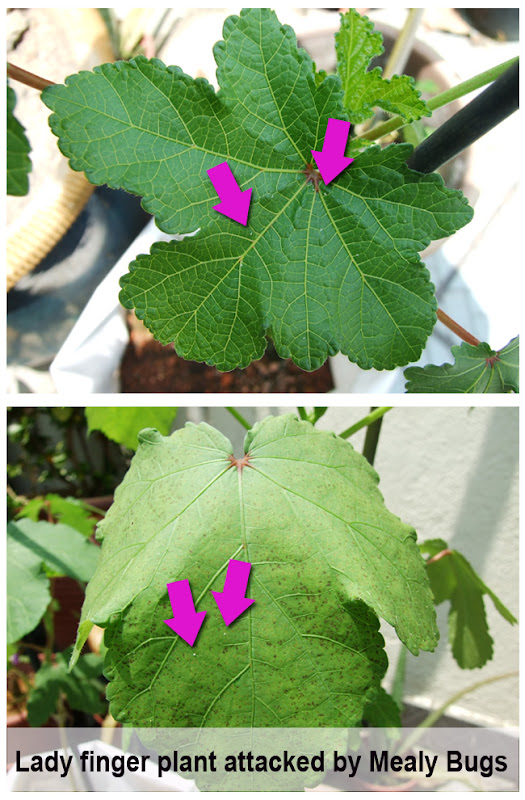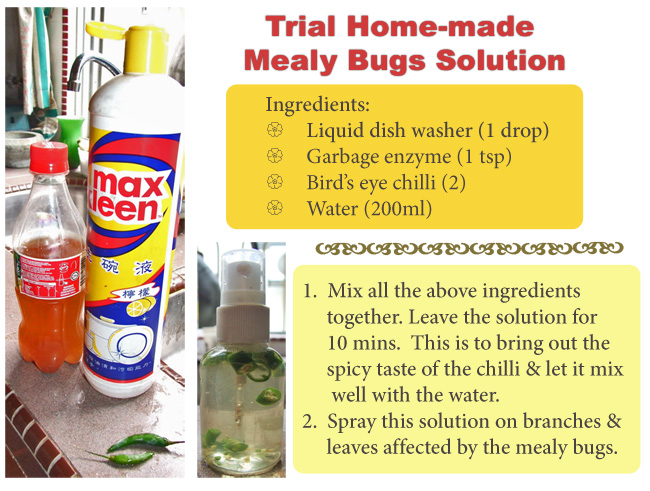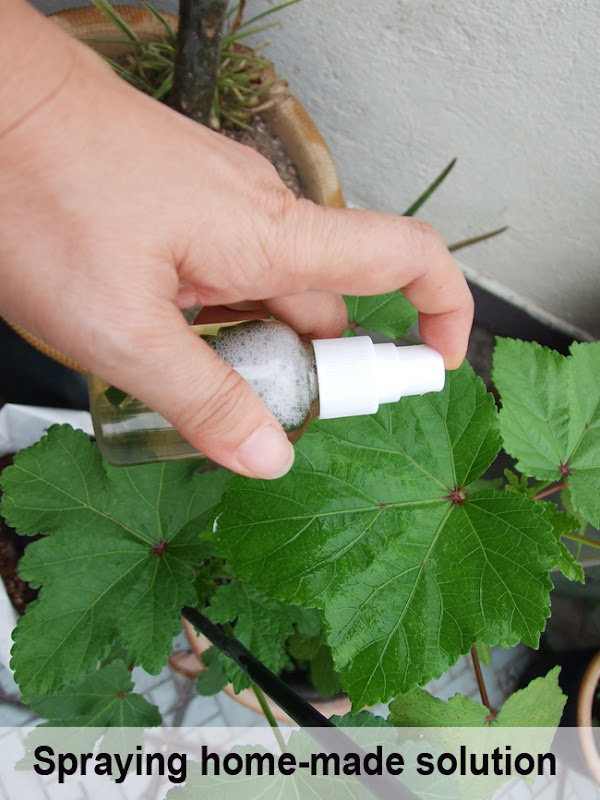My plants have been persistently attacked by mealy bugs. They went for my YTT, Hibiscus, Roselle and also lady fingers.
The mealy bugs would usually be found hiding on the underside of leaves. They thrive under the shady leaves and multiply very fast. If not act upon quickly, they will suck away the life of the plants. They remind me of vampires! As a result, the leaves of plants would have brown spots or gradually turn yellowish. Eventually the leaves would drop off after their nutrients have all been sucked by the mealy bugs.
Some facts about mealy bugs:
Mealybugs damage plants by sucking sap from roots, tender leaves, petioles and fruit. They excrete honeydew on which sooty mould develops.
They excrete honeydew on which sooty mould develops. Severely infested leaves turn yellow and gradually dry. Severe attack can result in shedding of leaves and inflorescences, reduced fruit setting and shedding of young fruit. The foliage and fruit may become covered with sticky honeydew, which serve as a medium for the growth of sooty moulds.
Honeydew, sooty mould and waxy deposits may cover leaves reducing photosynthetic efficiency and may lead to leaf drop. Contamination of fruit with honeydew and with sooty mould reduces its market value. The honeydew attracts ants, which collect the honey and protect indirectly mealybugs from natural enemies. Some mealybugs inject toxic substances while feeding causing deformation of the plant (e.g. the cassava mealybug). Some species transmit viruses (e.g. the pineapple mealybug). (Source: Infonet-Biovision)
That was exactly what happened to my Roselle, as shown in picture below. What remains of my Roselle are only dried leaves & shrivalled branches with some recalcitrant mealy bugs still hanging on to them.
The little white spots that appear on leaves may be a sign of mealy bugs presence. They seem like harmless dust. Another sign of mealy bugs presence is ants! If you can see many ants crawling on your plants with white cottony spots appearing on your plants, most likely your plants have been invaded by mealy bugs. Act fast! If left for too long, a healthy plant will have brown spots like the second photo below showing my lady finger leaf with brown spots. Usually, I will wash off the mealy bugs with water. But this is not a lasting solution. The next day they would return again.
After reading TropicalGardening's blog and some other internet articles, I used the home-made solution below. This is still a trial formulation. I only made 200ml of this solution as they would be enough for one application. I prefer to make fresh new ones for each application. I sprayed them generously on the mealy bugs either early morning or late evening.
Please do not spray this solution when it's hot & sunny as the garbage enzyme may scorch the plants. A little garbage enzymes will go a long way. So do not use too much of it. If you do not have this, you can opt to exclude it.
Be cautious when spraying this solution and ensure that the mixture does not come in contact with your skin or eyes. The spicy mist can hurt one's eyes & skin.
Stay a distance when spraying. The spiciness of bird's eye chilli will be emitted during spraying and can cause one to break into coughs.
Additional information that I found on the Internet:






10 comments:
Mealy bugs are a menace in my garden too. They have special affinity for Hibiscus and Cestrum nocturnum and when they swell in numbers they attack all members of my garden. Thanks for this homemade solution.
Yeah, they really like Hibiscus! Mine was infested too. I used Yates natra soap a number of times to get get rid of the mealy bugs. Lastly I used a water hose to spray water strongly onto the plant especially at those areas underneath the leaves. Now they are gone (I hope they won't come back again!). Your concoction is really a good idea. Actually, I have learnt the same solution before from another blogger but without the enzyme.
Have a great weekend and enjoy your new home!
Alcohol on a cotton tipped applicator (Q-tip) is what I use to go after each little offender individually.
The invasion had just started as I noticed that they have taken over my begonia, hibiscus.
My Angelonia & wishbone flower are badly effected.
Though organic solution are good but they seemed to be very temporary. I had tried very times but they always find a way to comeback.
IF you give-up - Just get those real pesticide from the garden store and spray well for 3 days and you have a free clear garden free from pest for months.
A very interesting and informative post. We all suffer, I mean the plants, from mealy bugs attacks. I hate them, because they are hard to get rid of. My main sufferers are rosette succulents. Thanks for the spray recipe. Have a nice day.
JC - I have bought this pesticide (Wesco Malathion 57)
It is very effective and also do consider the poison that its also harmful.
I had found that the pestcontrol guys who spray at homes for the whiteants & termites use this pesticide too.
(of course, they don't share their secret - but you will know it by the white liquid colour & the smell)
The liquid need to be diluted & it would turn white once in contact with water.
It had been used for the rice field. Once used, the pest do not visit your garden for years.
I can't even remember when was the last time I used this chemical.
Good luck!
This is a great inspiring article.I am pretty much pleased with your good work.You put really very helpful information...
pest control san antonio
This is a great inspiring article.
http://grsshoes.com/
Post a Comment